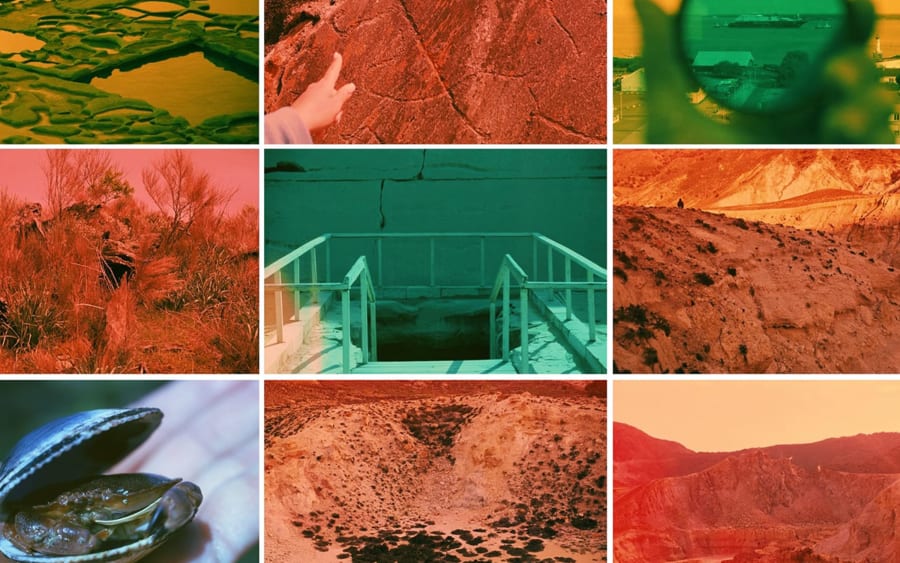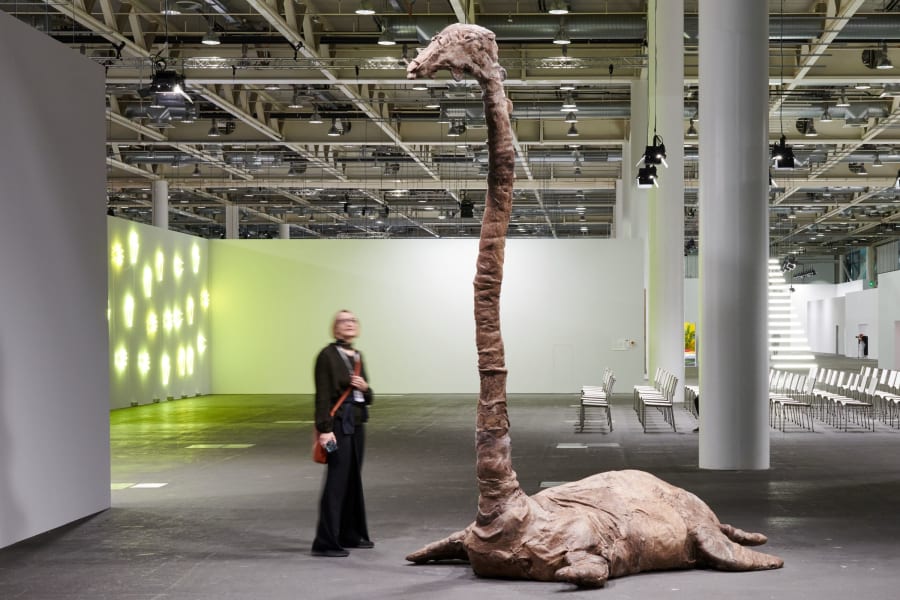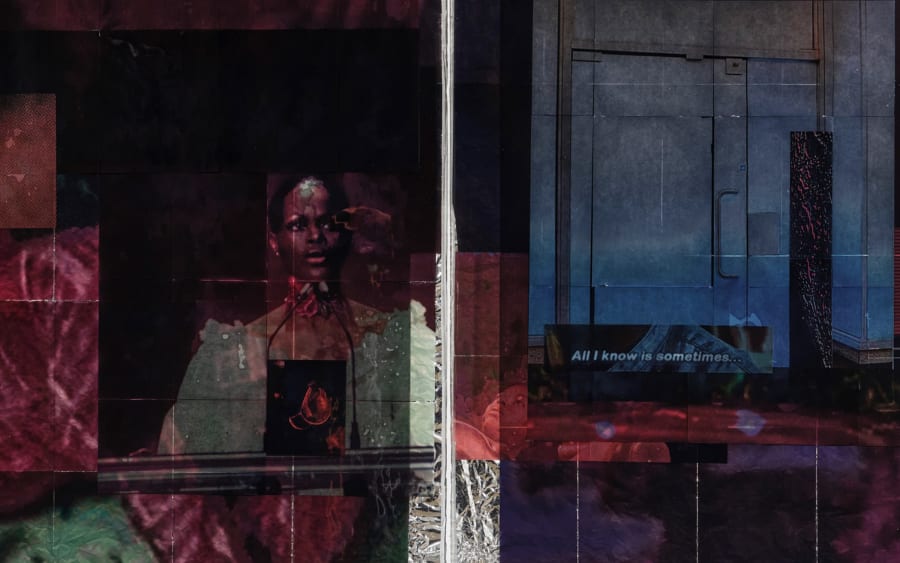Great art isn’t limited to the white cube. This June, compelling works are spilling into the streets, halls, and department stores of Basel. From immersive simulations to megalithic marble sculptures, we spotlight standout works in Parcours and Unlimited that push the limits of space, scale, and imagination.
Nicola Turner, Danse Macabre, 2025
Presented by Annely Juda Fine Art (London) in Unlimited
Don’t worry, that looming creature hanging above Hall 1:0 won’t bite. Danse Macabre by Nicola Turner is a twisting, larger-than-life sculpture made from a mass of salvaged horsehair and raw wool sourced from the area around her studio in Bath, UK. Suspended from the ceiling, each strand twists and sags to evoke a body in motion or decay. The work takes its name from a 15th-century mural once painted on the walls of Basel. The controversial painting, which represented death as a social equalizer, especially during plagues, was torn down in 1805 by locals who declared it scandalous.
Daniel Dewar & Grégory Gicquel, Stone triptych with snails, body fragments and sewing machine, 2025
Presented by Antenna Space (Shanghai) and Jan Kaps (Cologne) in collaboration with Loevenbruck (Paris) in Unlimited
Three megalithic pink marble sculptures rise like oversized fossils or relics of a distant future. Out of surfaces hand-carved from Rosa Aurora marble emerge textured forms suggesting brains, torsos, and a sewing machine. British-French artist duo Dewar and Gicquel have long been committed to traditional craft, particularly methods considered redundant in modern times. Citing references such as Japanese netsuke and post-industrial debris, this latest project explores the connection between manual labor and material culture.
Ayan Farah, Desert Seeds, 2025
Presented by Kadel Willborn (Düsseldorf) and Galerie Nordenhake (Berlin, Mexico City, Stockholm) in Unlimited
Ayan Farah’s monumental wall work Desert Seeds is landscape painting made with the land itself. Stretching over 12 meters in length, the earth-toned work is comprised of natural materials deeply personal to the artist. First, clay from the Sanaag region of Somalia – where Farah’s parents were born – and second, cloud-seeded water from the UAE, where she spent part of her childhood. Onto this naturally dyed fabric, Farah embroiders images of extinct desert flora. Labor-intensive and materially exacting, the work is a tactile meditation on nature and artifice, personal history and displacement.
Su Meng-Hung, Desolate Landscape on the Golden Screens, 2025
Presented by Tina Keng Gallery (Taipei) in Unlimited
We might typically think of traditional Chinese screens being used to divide a space, but Taiwanese artist Su Meng-Hung’s Desolate Landscape on the Golden Screens
transforms them into a lush, destabilizing stage. In this installation, eight ebony lacquer screens are arranged for visitors to stroll around. Each one has been painted on both sides with flowers, birds, and sensual imagery drawn from classical Chinese texts such as the 17th-century painting technique book Manual of the Mustard Seed Garden, 18th-century masterpiece Dream of the Red Chamber, and the 16th-century erotic classic The Golden Lotus. With a style that blends Eastern motifs with Western abstraction, the double-sided installation explores dualities of the sacred and profane, public and private, fantasy and control.
Nadira Husain, The Haunted Museum, 2025
Presented by PSM (Berlin) in collaboration with Hua International (Berlin, Beijing) in Unlimited
Since the 1920s, the regal bust of Nefertiti has been housed in Berlin’s Neues Museum, where she has been revered by visitors over the last century. But what if the Egyptian queen arrived in Germany today? Nadira Husain’s wooden triptych The Haunted Museum features three large-scale, freestanding panels painted with vibrant, fictional reinterpretations of Nefertiti as a contemporary immigrant. In them, the queen goes about life as a common person, dressed in Adidas tracksuits. Blending historical reference with humor and speculative fiction, the work draws attention to the enduring legacy of colonial-era artifact displacement thereby inviting consideration of what restitution might look like through a real-world lens.
Thomas Bayrle, Coats, 1967-68 / 2025
Presented by neugerriemschneider (Berlin) in Parcours
Weather forecast predicting rain? No sweat. Step into Thomas Bayrle’s Coats, installed in Basel’s Manor department store on Greifengasse, where the German artist offers his hypnotic twist on the humble raincoat. For this Pop Art-inspired pop-up, Bayrle reprises his 1968 design for a raincoat – transparent, plastic, and printed with one of his signature repetitive motifs. The pattern spreads, with Bayrle covering the surrounding space in wallpaper in a nod to both mass manufacturing and modernist formalism. Equal parts boutique and artwork, the booth simultaneously pokes fun at and indulges in mass production. Who says Pop Art doesn’t do practical?
Theo Triantafyllidis, Drift Lattice, 2025
Presented by The Breeder (Athens) in collaboration with Meredith Rosen Gallery (New York) in Parcours
Can marine life and synthetic matter coexist? Greek artist Theo Triantafyllidis offers a speculative answer in Drift Lattice, a live video simulation in which oceanic creatures and manmade waste interact in an endlessly evolving loop of entropy and clean-up. The work is a continuation of the artist’s Bugsim (Pheromone Spa) (2022), which used a microscopic terrarium to explore environmental repair. Projected across a triple-screened video wall, Drift Lattice’s digital ocean teems with crabs, seabirds, floating nets, and drones. Each entity is powered by a gaming system and governed by its own AI parameters, creating infinite, unscripted permutations.
Yu Ji, Foraged, 2025
Presented by Sadie Coles HQ (London) and Kiang Malingue (Hong Kong, New York) in Parcours
Old meets new at a historical Basel banqueting hall. Operating since 1860, the house, hotel, and restaurant Rheinfelderhof is one of the oldest family-run businesses in the city. Inside its traditional banquet room, Shanghai artist Yu Ji makes a discreet intervention: Concrete figures and sculptural fragments resembling bread, shells, and fruit are placed among tables and chairs, while second-hand mirrors disperse partial reflections across the space. Suggesting both give and take, these sculptural gestures echo Yu’s broader practice, which explores how memory, material, and the body intersect in places shaped by time.
Art Basel in Basel will take place from June 19 to 22, 2025. Get your tickets here.
Elliat Albrecht is a writer and editor based in Canada.
Caption for header image: Detail of a work by Su Meng-Hung, presented by Tina Keng Gallery at Art Basel Hong Kong 2025.
Published on June 11, 2025.


